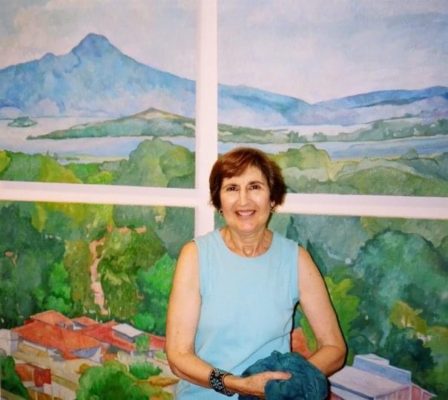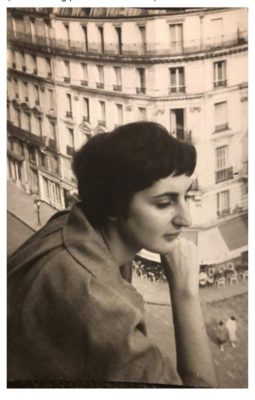Obituary
“Weisbord earned a BFA from the University of Illinois and a Max Beckmann fellowship to the Brooklyn Museum. In 1958, her self-portrait, “Woman in Black,” was reproduced in the Sunday New York Times four months before her departure via steamship for three years of living and painting in Rome. The passions she pursued in Europe grew stronger throughout her life, for literature, languages, travel, theater, food, and, most of all, painting.
She was an early member of the Prince Street Gallery. The dollhouse-themed canvases of her first show were reproduced in Joan Larkin’s book of poetry, Housework (Out & Out Books, 1975). Larkin recalls Weisbord’s influence, “Her fierce ardor for making others see what she saw, whether in a work of art or a woman’s psychology, ignited a revolution in my life and work.”
In the early 70s, she produced feminist programming for WBAI-FM. Her “The Blood-Jet is Poetry: the Life and Work of Sylvia Plath” unearthed recordings, bringing Plath’s voice to US airwaves for the first time. She went on to invite readings from the emerging poets Audre Lorde, Adrienne Rich, Robin Morgan, and Verandah Porche, among others.
Weisbord taught art at CUNY’s City College. She had a residency at PS1 in Queens long before it was associated with MOMA and several more at Producción Gráfica in Patzcuáro, Michoacán. In 1978 she bought raw industrial space in SoHo, sanded the floors herself, and helped form City Studios Co-op of “Artists Living and Working,” where she did just that for over 40 years.
Her paintings offer penetrating commentary on domestic life. They include still lifes in watercolor or oil, house portraits, and sculptural pieces. In 1981, Thomas Hoving interviewed her for ABC Nightly News as a pioneer in the artistic use of the color XEROX machine. She created outsized works inspired by vintage linoleum and wallpaper. Additional phases saw her bookbinding (for which she won a CAPS grant from the New York State Council on the Arts), scene painting, planning city murals, printmaking, and building with synthetic clay. “About the House,” her solo show at Gallery 107 in Brooklyn was reviewed in Art in America in 1996.
In recent years, she transitioned from romantic landscapes to capturing “random acts of still life” — street-level industrial scenes — her way of grieving her neighborhood’s perpetual chaos and transformations. [That was her 2014 PSG show]
Her cousin Dotty Attie (a founder of the A.I.R. Gallery) notes, ‘Mimi always seemed naturally to be several steps ahead of almost everyone else, simply by following her passions, never by looking for the next big thing.'”
Link to the New York Times Obituary
Excerpts from the NY Times Obit.
Mimi Weisbord, artist, teacher, author, and radio producer passed peacefully Saturday, May 2. With the support of her caregivers, Weisbord was serenaded for her last hour by her children and grandchildren via FaceTime. She tested positive for Covid-19, but her cause of death was unrelated. She was 84.”
“…She was an early member of the Prince Street Gallery. The dollhouse-themed canvases of her first show were reproduced in Joan Larkin’s book of poetry, Housework (Out & Out Books, 1975). Larkin recalls Weisbord’s influence, “Her fierce ardor for making others see what she saw, whether in a work of art or a woman’s psychology, ignited a revolution in my life and work.”







